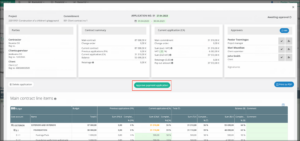Monitoring and managing construction costs is just one of several critical responsibilities for a general contractor. They must also pay attention to scheduling, quality, safety, and various other factors. However, when construction costs exceed the budget, it directly impacts the contractor’s financial bottom line.
This is precisely why mastering construction cost management processes is essential. A clear understanding of what construction cost management entails and the components of construction costs can be the key to a project’s success or failure. We will break down these concepts and outline the process of construction cost management, providing you with the tools to enhance your project management skills.
Table of Contents
What is cost management in construction?
Cost management in the construction industry refers to the process of planning, forecasting, budgeting, and controlling costs throughout the life cycle of a construction project. Its primary purpose is to ensure that the project is completed within the approved budget. Cost management is an important component of project management and includes several key stages:
- Planning and Estimating: This initial phase involves developing an initial budget based on the project’s scope and requirements. Estimating includes calculating the costs of materials, labor, equipment, and other resources needed to complete the project.
- Budgeting: Once the costs are estimated, the next step is to allocate the overall budget across the project’s various components or work packages. This budget serves as a financial blueprint for the project and is used to monitor and control costs.
- Cost Control: Throughout the construction cost management process, costs must be monitored and compared against the budgeted amounts. This involves tracking actual expenditures, forecasting future costs, and implementing measures to address variances between the budgeted and actual costs. Cost control helps identify financial risks early and allows adjustments to keep the project on budget.
- Reporting and Communication: Regular financial reporting is essential for effective cost management. These reports provide stakeholders with information about the project’s current financial status, including any cost overruns or savings.
Effective cost management in construction not only helps complete projects within budget but also contributes to the project’s overall success by enhancing decision-making, improving resource allocation, and increasing profitability for contractors and stakeholders. It requires the collaboration of the entire project team, including project managers, cost engineers, contractors, and clients.
Bauwise construction cost management software is designed to help general contractors keep projects on budget and within scope. By allowing users to upload their project budgets and track estimated versus actual costs in real-time, Bauwise provides an efficient way for construction companies to identify and correct overspending quickly. It also offers cost forecasting to pinpoint potential profits or losses per cost item. Start with Bauwise for free and gain the advantage of managing your construction costs more effectively and proactively.
What Is a Construction Cost?
Construction costs are the total expenses incurred to build a structure, facility, or project. This can encompass a wide range of costs, including, but not limited to, materials, labor, equipment, services, and other expenses directly related to the construction process. Construction costs can be categorized into several types:
- Direct Costs: These include expenses directly associated with the construction activity, such as materials, labor, and equipment used on the project.
- Indirect Costs: Indirect costs are not directly tied to the physical construction but are necessary for the project’s completion. Examples include administrative expenses, security, temporary facilities, and utilities for the construction site.
- Labor Costs: Arte the expenses associated with hiring construction workers, supervisors, and subcontractors. This can include wages, benefits, and insurance.
- Material Costs: The cost of all materials and supplies used in the construction project, including concrete, steel, wood, and finishing materials.
- Equipment Costs: The cost of purchasing or renting construction equipment such as cranes, bulldozers, and scaffolding.
- Overhead Costs: These are costs related to the general running of the project but not directly tied to the physical construction, including office expenses, legal fees, and permits.
- Profit: The margin added by the contractor for their services.
The total construction cost is essential for budgeting and financial planning for any construction project. It helps determine the project’s feasibility, secure financing, and ensure that the project stays within budget. Estimating construction costs accurately is crucial to the success of any construction project, as underestimation can lead to financial shortfalls, while overestimation can affect the project’s competitiveness and feasibility.
Construction Cost Management Process
Effective cost management is critical to completing projects on budget and on time in the construction industry. Careful and effective construction cost management also ensures the project remains financially viable and sustainable throughout its life cycle. The following guide discusses the seven essential steps in the construction cost management process, providing insight into how each step contributes to the overall financial health of construction projects.
1. Create a Cost Breakdown Structure
Initiating a construction project requires a detailed understanding of its financial components, which can be achieved by developing a cost breakdown structure. This analytical tool breaks down total project costs into manageable segments presented in a hierarchical chart format, where each entry represents a distinct cost category, item, or organizational effort. By focusing on task-based costs, CBS facilitates detailed bottom-up financial analysis, providing a comprehensive and accurate cost view compared to broad top-down estimates. This method allows general contractors to access detailed cost data at each project phase, providing a more nuanced financial perspective than a general total project cost estimate.
2. Estimate Construction Costs Precisely
Leveraging the Cost Breakdown Structure (CBS) is essential to accurately determine the financial costs of construction projects. Accurate cost estimates are critical because they directly affect the likelihood of maintaining a profit margin throughout the project’s life cycle. However, the pursuit of accurate cost estimation and forecasting is far from easy. Despite the advantages offered by estimating methods such as CBS, there are still many things that could be improved. Obtaining materials from various sources, allocating time, and many other intricacies involved in construction require thorough attention. Thus, the accuracy of the cost estimate requires not only a comprehensive understanding of these factors but also a strategic approach to integrate them into the financial planning process, ensuring a safer and more profitable execution of the project.
3. Create a Construction Budget
Preparing a detailed construction budget is an essential step in the construction cost management process. This stage is based on preliminary cost estimates, turning them into a concrete financial plan with the help of quotations from suppliers and contractors. This plan not only facilitates accurate accounting and financial oversight for the client or developer but also provides important insights to the general contractor. It allows you to identify the project’s schedule to be carried out, delineates the necessary expertise and the number of team members, and determines the equipment and resources necessary for the successful completion of the project.
A critical component of any construction budget is the inclusion of a contingency fund. This reserve, usually a percentage of the total project cost, is set aside to cover unexpected costs that may arise, such as adverse weather conditions, changes in personnel costs, or changes in project specifications. This contingency allowance must be integrated into project schedule right from the budgeting stage rather than added as an afterthought. By doing so, project managers are better prepared to deal with unforeseen challenges, ensuring the financial health and stability of the project throughout its duration.
4. Establish a Cost Baseline
After your budget has been finalized and approved, the next critical step is to establish a cost baseline. This baseline serves as a financial benchmark for general contractors and project managers, enabling them to monitor deviations between the projected budget and the actual expenditures. It allows for a direct comparison of what was expected to be spent versus what is being spent in reality, making this comparison indispensable for managing costs effectively.
Identifying when project expenses exceed the planned budget at any point during the project lifecycle is invaluable. It empowers managers and project teams to take timely corrective actions to realign the budget, ensuring financial control and project viability. The cost baseline, which includes all related costs, the project’s timeline, scope, and the required resources, is pivotal for tracking project progress and ensuring that everything proceeds according to plan.
5. Track Construction Costs During Project Execution
Effective cost management is achieved through vigilant monitoring of construction costs throughout the execution phase of a construction project. This critical process involves continuously tracking costs and comparing expenditures to the established cost baseline to identify potential financial variances. By actively monitoring costs, project managers are empowered to make data-driven decisions, adjust strategies, and implement necessary adjustments to ensure the project stays on budget. Such monitoring not only helps to maintain financial discipline but also provides insight into the efficiency of resource utilization.
The cost baseline serves as a final reference point that reflects the budgeted figures before the start of the project. This baseline is important in the simultaneous execution, monitoring, and control phase, providing a framework for financial supervision. Using construction project management software tools greatly improves this process. Such software includes comprehensive tools, including dashboards and detailed reporting capabilities that provide a dual perspective: a broad overview and detailed analysis of the project’s financial health and overall progress. Cloud-based platforms that provide project managers with instant access to data are preferred. This immediacy is critical to quickly identifying and correcting any financial variances, ensuring that project goals and budget constraints are consistently aligned.
6. Control Construction Costs
Effective management of construction costs demands a proactive approach to keep projects within their allocated budgets. This encompasses deploying cost-reduction techniques, securing more favorable deals from suppliers and subcontractors, monitoring risk and ensuring the efficient use of resources. The essence of project cost control lies in ongoing vigilance and the readiness to swiftly tackle any financial discrepancies that threaten to push costs beyond planned limits.
Key to project success in this process is not just the tracking of expenses but also their thorough analysis to identify opportunities for reducing overall project costs, thereby enhancing profitability. Project managers prioritize the management of labor and material expenses, monitor actual expenditures against budget predictions, and scrutinize cost variances—discrepancies between expected and actual costs—to optimize return on investment and maximize profits.
A well-conceived budget, complemented by diligent monitoring of project progress, is the foundation of controlling construction costs. Implementing change control systems, effective time and cost management practices, and leveraging earned value analysis are crucial steps in this comprehensive construction management strategy. Together, these measures ensure that construction projects remain financially disciplined from inception through completion.
7. Control Changes to the Construction Plan
Finally, controlling changes to the construction plan is critical for maintaining budget integrity. Changes in scope, design modifications, or unforeseen challenges can significantly impact project costs. Implementing a structured change order process helps assess the financial implications of changes, obtain necessary approvals, and update the budget and cost baseline accordingly. This ensures that any changes are carefully managed to mitigate their impact on the project’s financial health.
Use Bauwise for construction cost management
Bauwise offers construction cost management software that helps you manage and track construction labor and material costs in real time. As a project manager, import your project Excel file to Bauwise and let the software do the rest. Get automatic cost forecasts, manage contingency budgets, and see where you are making a loss or profit. Make cost management easy with Bauwise!
Track Construction Costs With Real-Time Project Budget Dashboards
After you have imported your construction project budget to Bauwise, watch the dashboards, which automatically collect real-time data and display it on easy-to-read graphs and charts. Get an overview of your entire construction project budget profit forecast, profit by actuals, commitments, and overall project completion.
Use Multiple Reports to Manage Construction Costs
We offer several reports that help you manage and track construction costs. If you’re working on multiple projects, use our portfolio report to determine your construction project’s financial status. See each project’s total cost, forecast, profit forecast, cost variance, forecast variance, actual costs, actual revenue, and other financial metrics essential for you. Construction project managers can also see their construction projects’ monthly reports, gross profit reports, and cash flow reports. Improve your cost management with Bauwise today!
About the Author

Taavi Kaiv
Taavi Kaiv is a construction specialist with over ten years of experience in the construction industry. Taavi is an accomplished construction project manager with many successful projects that have been completed under his guidance. Taavi holds a master’s degree in construction management from the Tallinn University of Technology. View profile
Related posts
Read our articles where you can find useful and relevant information about construction cost management:
- Ultimate guide to construction cost management
- Tips to Improve Construction Cost Management
- 10 Tips to improve cost control in your construction projects
- How to Manage Construction Costs: A Comprehensive Guide
- 10 Ways to Track Construction Project Costs
- What is Cost Reporting in Construction: A Comprehensive Guide





